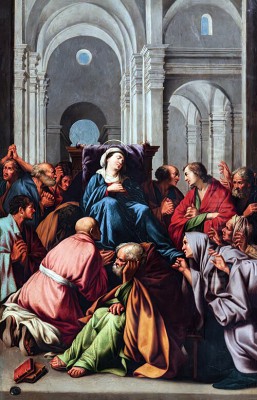
Carlo Saraceni, a pivotal figure bridging Venetian colorism with Roman Caravaggism, carved a unique niche for himself in the vibrant artistic landscape of the early 17th century. Though his career was relatively short, spanning just over two decades, his distinctive style, poetic sensibility, and significant commissions left an indelible mark on the Baroque era. His life and work offer a fascinating glimpse into a period of profound artistic transformation, characterized by dramatic innovation and intense rivalries.
Venetian Beginnings and Early Training
Carlo Saraceni was born in Venice, likely around 1579, though some earlier sources suggested a birth year closer to 1585. The city of Venice, with its rich artistic heritage dominated by titans like Titian, Tintoretto, and Veronese, undoubtedly shaped his early visual vocabulary. The Venetian school was renowned for its emphasis on colorito (color) over disegno (drawing and design), its atmospheric effects, and its sensuous depiction of textures and light.
While concrete details about Saraceni's initial training in Venice are scarce, it is generally believed that he may have been associated with the workshop of Palma il Giovane, a prolific and influential painter in late 16th-century Venice. Palma il Giovane himself was a successor to the great Venetian tradition, and any apprenticeship under him would have instilled in Saraceni a deep appreciation for rich palettes, dynamic compositions, and the expressive potential of oil paint. Another artist sometimes mentioned in connection with his early development is Giovanni Bassano, part of the Bassano family workshop known for their genre scenes and religious paintings imbued with rustic naturalism. This Venetian grounding in color, light, and a certain naturalism would remain a subtle but persistent undercurrent throughout his career, even as he embraced new influences.
The Lure of Rome: A New Artistic Horizon
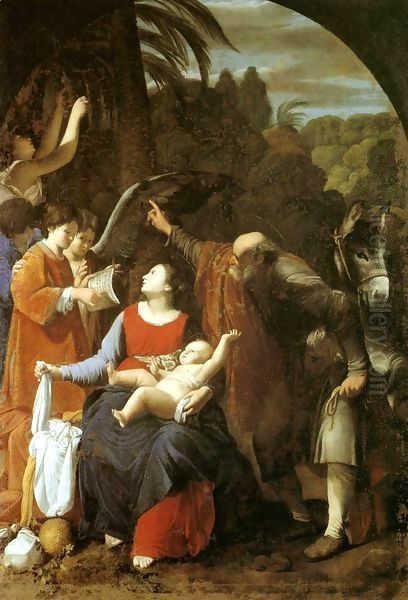
By 1598, or shortly thereafter, Saraceni made the pivotal decision to move to Rome. The Eternal City at the turn of the 17th century was the undisputed center of the European art world, a magnet for ambitious artists from across Italy and beyond. It was a place of immense papal and private patronage, offering unparalleled opportunities for commissions and artistic exchange. Rome was a melting pot of styles, but two dominant forces were shaping its artistic direction: the classicism revived by Annibale Carracci and his followers, and the revolutionary naturalism championed by Michelangelo Merisi da Caravaggio.
Upon arriving in Rome, Saraceni would have encountered a dynamic and competitive environment. He initially found a niche working with the German painter Adam Elsheimer, a highly respected artist known for his small, meticulously detailed cabinet paintings, often on copper, characterized by poetic landscapes and innovative use of light, particularly in nocturnal scenes.
The Influence of Adam Elsheimer
Adam Elsheimer, though German, was a significant figure in Rome. His small-scale works, rich in narrative detail and atmospheric effects, captivated a discerning circle of patrons and fellow artists, including Peter Paul Rubens. Saraceni's association with Elsheimer, possibly as an assistant or collaborator, was crucial. From Elsheimer, Saraceni likely refined his technique for painting on copper, a support that allowed for a smooth, jewel-like finish and enhanced the luminosity of colors.
Elsheimer's influence can be seen in Saraceni's own small-scale mythological and biblical scenes set in evocative landscapes, where the figures, though central, are often integrated into a broader, atmospherically charged environment. The German master's penchant for nocturnal scenes and dramatic lighting, distinct from Caravaggio's more direct tenebrism, also left its mark on Saraceni, encouraging a more poetic and nuanced approach to light and shadow. Works like Saraceni's Rest on the Flight into Egypt or landscapes with mythological figures often show this Elsheimerian sensitivity to nature and delicate light effects.
The Overwhelming Impact of Caravaggio
While Elsheimer provided a foundation in refined technique and poetic landscape, the most transformative influence on Saraceni in Rome was undoubtedly Caravaggio. Caravaggio's dramatic use of chiaroscuro (strong contrasts between light and dark), his uncompromising naturalism, and his emotionally charged depictions of religious and secular subjects were revolutionizing Roman painting. Saraceni, like many of his contemporaries, was drawn into Caravaggio's orbit, becoming one of the earliest artists to be identified as a "Caravaggisto" – a follower of Caravaggio's style.
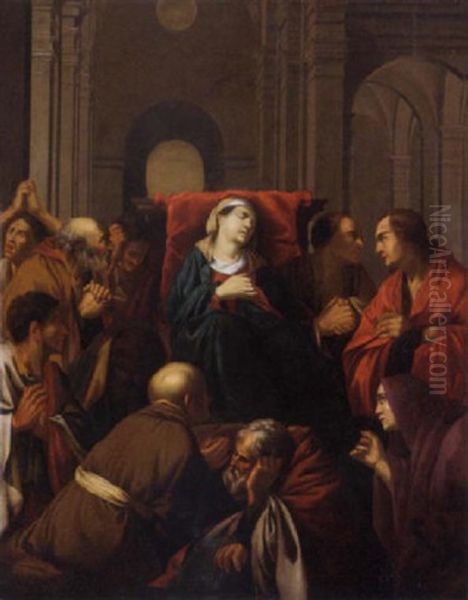
Saraceni adopted Caravaggio's tenebrism, using directed light to highlight figures against dark backgrounds, creating a sense of immediacy and drama. He also embraced the practice of painting directly from life, lending his figures a tangible, human presence. However, Saraceni's interpretation of Caravaggism was always tempered by his Venetian heritage and his own gentler artistic temperament. His shadows are often softer, his figures less rugged, and his overall mood frequently more lyrical and less confrontational than Caravaggio's. Artists like Orazio Gentileschi, another prominent Caravaggisto, similarly developed a more refined and elegant version of the style.
Saraceni's Unique Synthesis: Venetian Color and Roman Drama
Carlo Saraceni's mature style is best understood as a personal synthesis of these diverse influences. He masterfully blended the rich, warm palette and atmospheric qualities of Venetian painting with the dramatic chiaroscuro and naturalistic detail of Roman Caravaggism, often infused with the poetic intimacy he may have absorbed from Elsheimer.
His figures, while realistically rendered, often possess a certain grace and elegance. His use of color remained vibrant, even within the tenebrist framework, with rich reds, blues, and golds enlivening his compositions. He was particularly skilled in rendering the textures of fabrics – silks, velvets, and brocades – a testament to his Venetian eye for sensuous detail. This ability to combine dramatic lighting with a sophisticated color sense and attention to material richness distinguished him from more austere Caravaggisti like Bartolomeo Manfredi or the Spanish Jusepe de Ribera (who also spent time in Rome).
Major Commissions and Religious Works
Saraceni's talent did not go unnoticed, and he received several important public commissions in Rome. These included altarpieces and decorative cycles for prominent churches, which solidified his reputation.
One of his most significant early commissions was for the church of Santa Maria in Aquiro. He also contributed to the decoration of the Sala Regia in the Palazzo Quirinale, a prestigious papal project, which further indicates his standing in the Roman art scene.
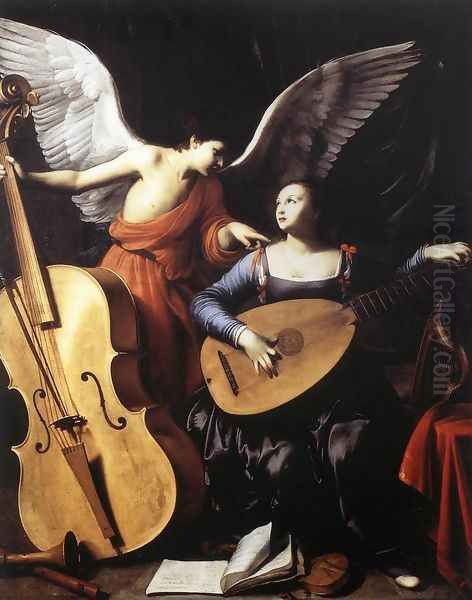
Perhaps his most famous commission involved the church of Santa Maria della Scala in Trastevere. Caravaggio had painted a Death of the Virgin for this church, but it was rejected by the Discalced Carmelite friars, possibly due to its stark realism and the perceived indecorous depiction of the Virgin. Saraceni was then commissioned to provide a replacement. His first attempt was also reportedly rejected, but his second version, completed around 1610 (though some scholars date it later, closer to his death), was accepted and remains in the church today. This work, The Dormition of the Virgin, is a masterpiece of his mature style. It skillfully balances Caravaggesque drama with a more tender, elegiac mood, and its rich colors and dignified figures were clearly more acceptable to the patrons. This episode highlights the complex artistic politics of the time and Saraceni's ability to navigate them successfully.
Other notable religious works include Saint Cecilia and the Angel, now in the Galleria Nazionale d'Arte Antica, Palazzo Barberini, Rome. This painting showcases his delicate handling of light, his refined figures, and a lyrical quality that is characteristic of his best work. The subject of Saint Cecilia, the patron saint of music, was popular among Caravaggesque painters, including Artemisia Gentileschi and Guy François. Saraceni’s version is notable for its gentle intimacy.
The Nativity is another theme he explored, allowing him to combine nocturnal lighting with tender human emotion, often incorporating elements of landscape that recall Elsheimer.
Secular Themes and Works on Copper
Beyond large-scale religious commissions, Saraceni also produced numerous smaller paintings, often on copper, for private collectors. These frequently depicted mythological subjects, biblical scenes with prominent landscapes, or allegorical figures. His skill in painting on copper, honed through his association with Elsheimer, allowed for exquisite detail and luminous color.
Works like Judith and the Head of Holofernes (Kunsthistorisches Museum, Vienna) demonstrate his ability to tackle dramatic Old Testament themes with psychological intensity, employing strong chiaroscuro to heighten the tension. While the subject was a favorite of Caravaggio and his followers (notably Artemisia Gentileschi's powerful renditions), Saraceni's version, while dramatic, often retains a degree of painterly refinement.
His Venus and Mars (versions exist, e.g., Museo Thyssen-Bornemisza, Madrid, though attribution debates sometimes arise for specific pieces) and other mythological scenes allowed him to explore the nude figure and to weave narratives within lush, atmospheric settings. These smaller works were highly sought after and contributed to the spread of his reputation. Moses Defending the Daughters of Jethro is another example where a biblical narrative is enriched by his attention to landscape and dynamic figure grouping.
Key Masterpieces in Focus
Several works stand out as defining examples of Saraceni's artistic achievement:
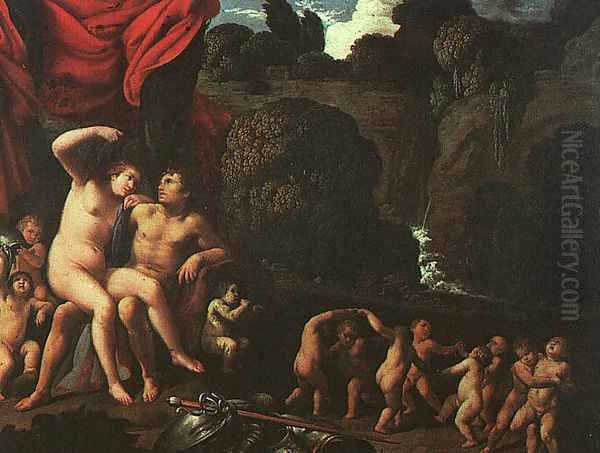
The Dormition of the Virgin (Santa Maria della Scala, Rome): As mentioned, this altarpiece is crucial. The composition is grand and solemn. The Virgin lies on her deathbed, surrounded by grieving apostles. Light falls dramatically from an unseen source, illuminating faces and gestures, while deep shadows envelop other areas. The colors are rich and somber, contributing to the painting's emotional weight. Compared to Caravaggio's rejected version, Saraceni's is more idealized and decorous, yet it retains a powerful sense of human sorrow and spiritual significance.
Saint Cecilia and the Angel (Galleria Nazionale d'Arte Antica, Rome): This work is celebrated for its lyrical beauty. Saint Cecilia, her face tilted upwards in gentle ecstasy, is visited by an angel. The interplay of light on her face and robes, the delicate rendering of the musical instruments, and the tender interaction between the figures create a scene of serene devotion. The warm tonalities and soft modeling are characteristic of Saraceni's more personal interpretation of Caravaggism.
Judith and the Head of Holofernes (Kunsthistorisches Museum, Vienna): This painting captures the dramatic climax of the biblical story. Judith, resolute but not without a hint of vulnerability, holds the severed head of the Assyrian general. The lighting is stark, emphasizing the gruesome trophy and Judith's determined expression. The rich fabrics and careful attention to detail are typical of Saraceni.
The Virgin and Child with Saint Anne (Galleria Nazionale d'Arte Antica, Rome): This work showcases Saraceni's ability to handle multi-figure compositions with grace and tenderness. The figures are arranged in a harmonious group, their interactions conveying familial love and devotion. The soft lighting and warm colors create an intimate atmosphere. This subject, often imbued with complex theological meaning, was also tackled by Leonardo da Vinci and later by Caravaggio himself.
Relationships with Contemporaries
Saraceni was an active participant in Rome's artistic community. His relationship with Caravaggio was complex. While clearly an admirer and follower of Caravaggio's style, there's also evidence of a more direct, and at times fraught, connection. Saraceni was reportedly involved in some of the legal entanglements that plagued Caravaggio. For instance, he was a witness in legal proceedings, including the trial concerning the murder of Ranuccio Tommasoni, in which Caravaggio was the prime culprit. There were even contemporary accounts, such as those by Caravaggio's biographer Giovanni Baglione (himself a painter and rival), suggesting Saraceni not only imitated Caravaggio's art but also his bohemian lifestyle, even going so far as to walk around with a large dog, much like Caravaggio did.
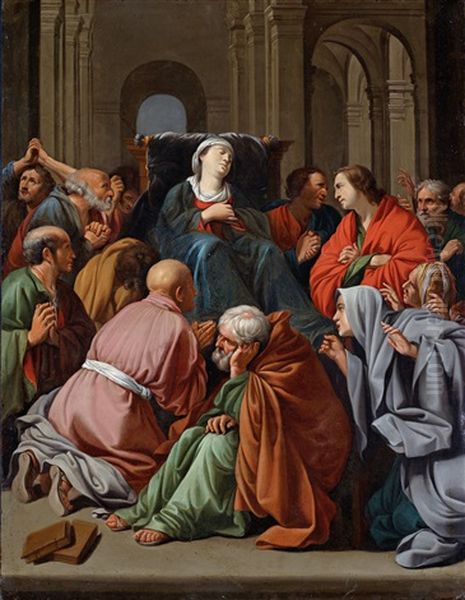
He maintained connections with other artists. His early association with Adam Elsheimer was formative. He would have known Orazio Gentileschi and his talented daughter Artemisia Gentileschi, both significant figures in the Caravaggesque movement. He also collaborated with or employed other artists. The French painter Jean Leclerc (Giovanni di Chere, Giovanni Le Clerc) from Nancy is documented as a student and collaborator who worked closely with Saraceni in Rome and later returned to Venice with him, helping to complete Saraceni's unfinished works after his death. Leclerc's own style shows a clear debt to Saraceni, particularly in his use of light and landscape. The enigmatic "Pensionante del Saraceni" (Saraceni's Boarder), an anonymous artist whose style is closely related to Saraceni's, further attests to his role as a mentor or at least an influential figure within a workshop setting.
Controversies and Legal Matters
Like many artists of the period, Saraceni's life was not without its share of drama. Beyond the artistic rivalries and the pressure of securing commissions, he was involved in legal disputes. As mentioned, he testified in cases related to Caravaggio. He himself was accused of perjury in one instance, indicating the often turbulent nature of life in 17th-century Rome.
The stylistic "contradictions" sometimes noted in his work – the oscillation between a more robust Caravaggism and a softer, more Elsheimer-influenced or Venetian style – are less a controversy and more a reflection of his artistic journey and versatility. He adapted his style to the subject matter, the scale of the work, and the preferences of his patrons, while always retaining a personal touch.
Later Years, Return to Venice, and Untimely Death
Around 1619-1620, after two decades in Rome, Saraceni made the decision to return to his native Venice. The reasons for this move are not entirely clear, but it may have been prompted by an invitation to work on a prestigious commission for the Doge's Palace – specifically, a large canvas for the Sala del Maggior Consiglio. This would have been a significant honor, marking a triumphant return to the city of his birth.
Tragically, Saraceni's renewed Venetian career was cut short. He died in Venice in June 1620, possibly from typhus, at a relatively young age (around 41). His collaborator, Jean Leclerc, and others may have completed some of his unfinished projects, including the Doge's Palace commission. Despite his premature death, he had already produced a substantial and influential body of work.
Legacy and Influence
Carlo Saraceni's legacy is significant, though perhaps sometimes overshadowed by the more dramatic figure of Caravaggio. He was a key figure among the first generation of Caravaggisti, helping to disseminate and adapt Caravaggio's revolutionary style. His unique blend of Venetian colorism with Roman tenebrism offered a more lyrical and accessible version of Caravaggism that appealed to a wide range of patrons.
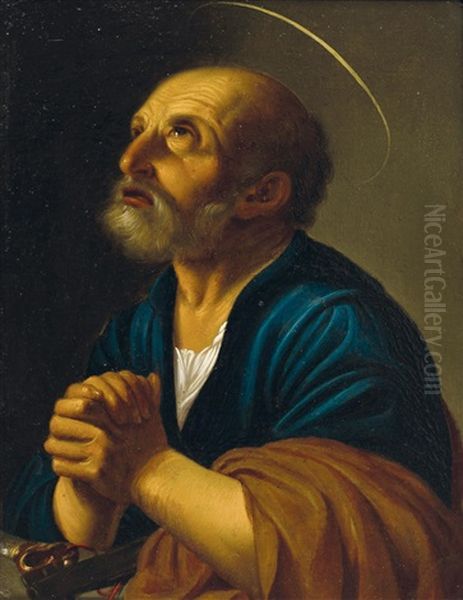
His influence extended to both Italian and foreign artists working in Rome. His student Jean Leclerc carried his style back to Lorraine, contributing to the spread of Caravaggesque tendencies in France, where artists like Georges de La Tour would develop their own powerful interpretations of light and shadow. While a direct line to Rembrandt is a broader claim, the general international spread of Caravaggism, to which Saraceni contributed, certainly formed part of the artistic climate that influenced Northern European painters.
Saraceni's works on copper, influenced by Elsheimer, also played a role in popularizing this medium for small, refined cabinet paintings. His ability to infuse religious and mythological scenes with poetic feeling and naturalistic detail ensured his enduring appeal.
Saraceni in Modern Collections and the Art Market
Today, Carlo Saraceni's paintings are held in major museums and private collections around the world. Besides the churches in Rome that still house his altarpieces, his works can be found in institutions such as the Galleria Nazionale d'Arte Antica (Palazzo Barberini and Palazzo Corsini) in Rome, the Kunsthistorisches Museum in Vienna, the Louvre in Paris, the National Gallery in London, the Museo del Prado in Madrid, and various museums in the United States, as well as in Lyon and Dijon.
In the art market, Saraceni's works appear periodically at auction. Prices can vary significantly depending on factors such as size, subject matter, condition, provenance, and the degree of certainty in attribution. His paintings on copper, often prized for their detail and luminosity, can command strong prices. For example, a Penitent Saint Peter fetched a respectable sum at Sotheby's, and other works like A Seated Man Recalling have appeared with significant estimates at Christie's. The attribution of works to Saraceni, his workshop, or followers like the Pensionante del Saraceni can sometimes be complex, requiring careful scholarly assessment, which also impacts market value. The sale of an Adoration of the Magi attributed to a student of Saraceni also indicates the continued interest in his circle.
Conclusion: An Enduring Poetic Vision
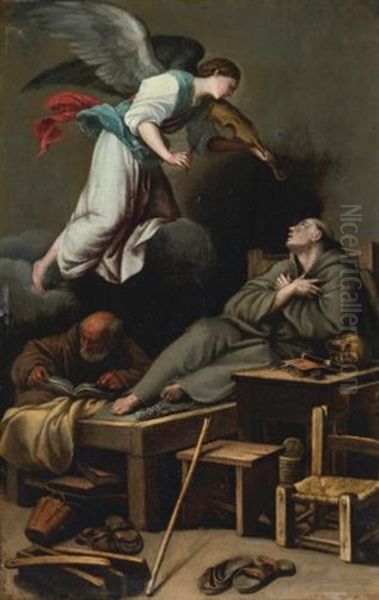
Carlo Saraceni stands as a distinguished and original voice in early Baroque painting. He navigated the powerful currents of Venetian tradition, Elsheimer's poetic naturalism, and Caravaggio's revolutionary realism to forge a style that was uniquely his own. His sensitivity to color and light, his ability to convey tender emotion, and his technical skill, particularly in his works on copper, mark him as a master of considerable talent. Though his life was cut short, his contributions to the artistic ferment of early 17th-century Rome were substantial, and his paintings continue to captivate viewers with their blend of drama, lyricism, and refined beauty. He remains a testament to the rich and diverse interpretations that emerged in the wake of Caravaggio, demonstrating that the Caravaggesque phenomenon was not monolithic but rather a catalyst for varied and individual artistic expressions.